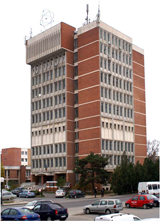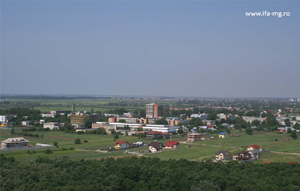IFA at just 60 years: looking to the future

I have read with much interest the articles in the previous issue of the bulletin “Courier of Physics” (CdF) published on the 60th anniversary since the inception of IFA (Nicolae Victor Zamfir – Director General of IFIN-HH and Dr. Eng. Mihail Balanescu – former Technical Director of IFA) as well as those comprised in the archive of the above mentioned publication written on the occasion of the 50th anniversary (Acad. Mihai Peculea), 45th anniversary (Mircea Oncescu – former Director of IFIN) and 40th anniversary (Gheorghe Pascovici – Director General of IFA at that time). I was pleasantly impressed by this initiative and I thank all whose who have written so beautifully about IFA. However, I have to confess that I felt a certain bitterness realizing that IFA, the institute that I represent, is virtually associated only to the past! Starting from IFA of the last years, I will try to give you a brief overview of the way the institute is heading with the hope that the 60th year is just one of the first terms of the series of anniversaries.
The activity performed by IFA in the last decade, that I consider to be the most important, is the coordination of Romania’s participation in the European programme of Controlled Thermonuclear Fusion (EURATOM-Fusion), part of the European Union’s framework programmes. The participation in the European Fusion Programme is performed through EURATOM-MEdC Association presently made up of 4 National R & D Institutes (NIRD) and 3 universities. Starting with the year 1999 when the Contract of Association with the European Commission has been signed, IFA has been designated as Research Unit of the Romanian Association and coordinates in this capacity the Association activity on all aspects (scientific, economic and administrative). At European level, the activities of research and development in nuclear field are carried out within a dedicated framework programme – EURATOM; in our country these activities are comprised in sub-programmes or thematic areas of the National Plan of Research, Development and Innovation (NPRDI) – CORINT within NPRDI-1 and CAPACITIES in NPRDI-2. On 26 and 27 November 2009 IFA will organize at Magurele the event “Days of Association EURATOM-MEdC”, when we will celebrate the 10th anniversary from the establishment of the Association EURATOM-MEdC. The results obtained by the Romanian Association are remarkable and highly appreciated both by its partners and the European Commission; I take this opportunity to congratulate all whose who have contributed to this programme up to the present. In the period 2001-2006 IFA managed the national programme “Basic Research of Socio-Economic Interest” (CERES) within NPRDI-1. Between 2001-2005 IFA coordinated three more areas (socio-economic and cultural, nuclear physics, basic research) within the programme “Research of Excellence” (CEEX). I will not go into details about these modules/programmes, finalized with excellent results, on my opinion, as they are well-known within our scientific community. I have mentioned them only to emphasize a common factor which seems to me to be quite significant: although “dismembered” in 1996 with the set-up of National R&D Institutes, IFA ensured successfully a certain coherence and cohesion of physics research in Romania.
Starting with January 2008, when I came at the helm of IFA, the institute’s priorities have been the following:
- Reorganization with a view to reintegrating the institute in the present R & D system – at that time IFA was performing its activity according to a Government Decision issued in 1990; the Government Decision No. 1608/04.12.2008 and the Decision of the National Authority for Scientific Research (NASR) No. 9642/30.03.2009 regulate, at least formally, the present activity of the institute.
- Continuation and strengthening of the coordination activity of Romania’s participation in EURATOM-Fusion programme; to this effect, in accordance with the Decision No. 9714/06.08.2008 issued by NASR, IFA has been re-designated as Research Unit of the EURATOM-MEdC Association for the period 2008-2013.
- Initiation of new activities to provide the institute a new perspective according to its newly assumed mission: that of integrator of Romanian physics; further on I will detail this aspect.

Following its reorganization IFA became a public institution, completely self-financed, subordinate to NASR, having as main objective the elaboration and implementation of a coherent and stimulating policy in the field of atomic and subatomic physics. The fulfillment of this objective involves projects execution; in order to participate in project-based competition IFA has been accredited to perform R & D activities according to NASR Decision No. 9618/18.02.2009. The first project won through tender by IFA – as coordinator, together with 16 research and educational institutes in the country (9 national R & D institutes and 6 universities) – refers to the “Evaluation of the Romanian research potential in physics and elaboration of the national strategy for international cooperation” (ESFRO). This project, included in the Sectoral Plan of the Ministry of Education, Research and Innovation/National Authority for Scientific Research, will have a duration of 2 years (September 2009-August 2011) and has a twofold objective: (i) establishment and implementation of a methodology enabling the identification and stimulation of research directions/teams having a genuine potential for developing and enhancing the visibility of the field and the socio-economic impact in Romania; (ii) elaboration of the strategy for Romania’s participation in big international collaborations in the field of physics, in short and medium term, in line with the national strategy and European strategy for construction and exploitation of large research infrastructures. The results of ESFRO project, awaited with interest by the scientific community and NASR, will also reflect our capacity for self-evaluation according to internationally acknowledged standards and for planning, as far as possible, our future. I hope that the evaluation and the strategy of this field will become permanent activities of the institute and will also contribute to the renewal of IFA’s spirit and standard in research.
Another direction, which I consider to be important for the entire physics community in Romania and to which IFA can significantly contribute is that of big international collaborations. Romania’s participation in Pan-European or even world scientific projects requires a coordination at national level providing consistency and coherence: such collaborations will engage research, educational and industrial institutes/units in the country. Unlike other fields of research, physics is highly involved in large-scale international collaborations. The most eloquent example may be the aforementioned EURATOM-Fusion programme whose main aim is the realization of International Thermonuclear Experimental Reactor (ITER) in collaboration with another six states (India, South Korea, USA, China, Japan and Russian Federation). IFA confirms its capacity to ensure the unitary coordination (scientific, economic and administrative) of Romania’s participation in this programme. Another Pan-European project in which IFA involves itself seriously from the beginning is “Extreme Light Infrastructure” (ELI), designed to build the most powerful laser in the world. 13 European Union member states participate in this project, five of which have already submitted their candidacy as host countries for ELI site. ELI consortium eventually decided on 3 ELI “pillars” to be constructed in the next 4-5 years in 3 different locations: Prague – in the Czech Republic, Szeged - in Hungary and Magurele - in Romania. Thus, Romania will host an important part (ELI-Nuclear Physics) of a Pan-European infrastructure, a fist ever in Romanian research! This success has been achieved following incredible efforts and represents an immense opportunity for the entire physics community in the country to participate in the construction and utilization of a large research infrastructure within an international partnership. Similar to EURATOM-Fusion programme, IFA can provide a unitary participation of specialized research institute in the country to ELI project. The examples can continue: CERN, to which Romania is on course to join; Dubna, to which Romania is among the founding member states; other projects of large European research infrastructures. There are also scientific institutes from abroad whose collaborations/projects scope is similar to those of the international organization in the field. A relevant example is the Commission for Atomic Energy (CEA) in France with which Romania collaborated and continues to collaborate at institutional level. I take also this opportunity to acquaint the scientific community in Romania that IFA will conclude a Framework Cooperation Agreement with CEA enabling the performing of joint scientific projects financed by both parties; the signing ceremony for the agreement will take place on 2 December 2009 at IFA.
IFA envisages also other activities designed to reinforce the physics research and the collaboration among specialized institutes in Romania. Starting with last year, IFA organizes almost every month scientific seminars of wide interest for the institutes on Magurele and in the country. The Conference Room located on the 9th floor of IFA building, with a seating capacity of 70-80 persons, has been refurbished and fitted out with modern projection equipment, including a high performance video conferencing system. Adjacent to it there is another room of approximately the same size, currently in the middle of refurbishing, dedicated for the housing of scientific events: parallel sessions, posters, internet, protocol etc. This Conference Centre may also be utilized for activities to further professional development and training for all staff. Furthermore, IFA intends - in collaboration with the institutes on Magurele as well as those from abroad and in the country – to fit out a Centre for Knowledge Development in Physics (a museum-laboratory of physics) with a view to attracting the young to this field of research and popularizing the great achievements in physics. Another future direction refers to the stimulation of technological transfer and innovation, of start-ups and spin-offs: IFA can provide areas dedicated to such activities and can facilitate the bringing together of research, business and industry. A further aim is to stimulate inter- and multidisciplinary research by creating “user facilities” – laboratories designed either to serve, at request, other research units both on Magurele and in the country, or to provide support for carrying out projects of joint interest. To this effect, IFA intends to apply for funding from EU structural funds: a first project – “Strengthening of the administrative capacity of IFA to enhance the potential for performing research, developments and innovation activities” (ADMIFA) has been evaluated and is proposed for financing; a second project – “National research facility for system analysis and synthesis at atomic level” (FANTASIA) is presently under evaluation.
What are the prospects for IFA to succeed in achieving these aims? It rests upon all of us! However, an essential prerequisite is to build up a critical mass of firm believers in IFA’s destiny as were its founders. I must confess that I’m quite optimistic about this: I had the pleasure to work with colleagues from other institutes in Magurele, especially a few young people, who have put tremendous efforts into an IFA project disregarding the fact that they work at different institutes even non-participating in the project. Not to mention that they did it for free. There are also older colleagues who still mention in their publications the name of IFA together with name of the institute they work at. I feel beside me colleagues - managers of research institutes – who are willing and ready to support IFA. I also have the confidence that IFA has many supporters from the whole country. I hope that together we shall build up a New IFA capable to restore and carry on the prestige of this emblematic institute of Romanian physics. To all who “believe in the future of the Institute of Atomic Physics and in the people who will provide its prosperity” – as the Acad. Marius Peculea worded so beautifully at the 50th anniversary of IFA, I thank them all!
December 2009
Dr. Florin Buzatu
General Director IFA


